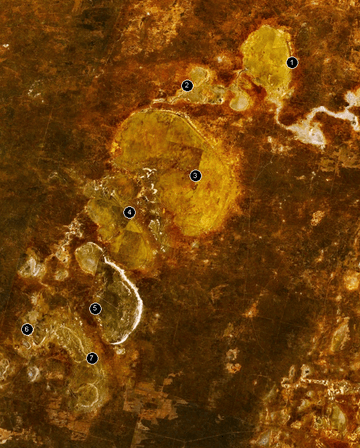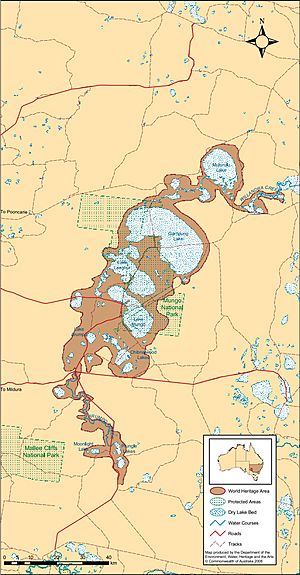Willandra Lakes Region facts for kids
| UNESCO World Heritage Site | |
|---|---|

Part of the Willandra Lakes system:
|
|
| Location | Far West, New South Wales, Australia |
| Criteria | Cultural and Natural: (iii)(viii) |
| Inscription | 1981 (5th Session) |
| Area | 240,000 ha (590,000 acres) |
The Willandra Lakes Region is a special place in south-western New South Wales, Australia. It covers a huge area of 2,400 square kilometres. This region is so important that it has been named a World Heritage Site. This means it has unique natural features and a rich cultural history.
Long, long ago, about two million years ago, there were many lakes here. Now, they are all dry. But for at least 50,000 years, Aboriginal people camped around these lakes. They especially liked the sand dunes along the lake shores. These dunes are shaped like crescents and are called lunettes.
One of the most amazing discoveries was made at Lake Mungo. In a lunette there, scientists found the world's oldest known cremation. This was the remains of a woman who lived more than 40,000 years ago. This discovery tells us a lot about early human history in Australia.
A small part of the Willandra Lakes Region is protected by the Mungo National Park. Besides Lake Mungo, there are other important lakes too. Lake Mulurulu was the last lake to hold water. The Prungle lakes have been dry for over 20,000 years. Lake Chibnalwood has a lunette that is 30 metres high, making it one of the biggest in the world!
The Willandra Lakes Region was also added to the Australian National Heritage List in May 2007. This list protects places that are very important to Australia's history and nature.
Contents
What Makes the Willandra Lakes Region Special?
The Willandra Lakes Region is famous for two main reasons: its amazing natural history and its deep cultural importance. It shows us how the environment has changed over thousands of years. It also gives us clues about how people lived in ancient times.
Ancient Landscapes and Dry Lakes
The lakes in this region were once full of water. Over time, the climate changed, and the lakes dried up. This created the unique landscape we see today. The dry lakebeds and the crescent-shaped sand dunes, called lunettes, are key features. These lunettes were formed by wind blowing sand from the dry lakebeds.
Evidence of Early Human Life
The Willandra Lakes Region is one of the most important places in the world for understanding early human history. The discoveries here show that Aboriginal people lived in this area for a very long time. They adapted to the changing environment and used the resources around the lakes.
The Story of Lake Mungo
Lake Mungo is the most famous part of the Willandra Lakes Region. It is where the oldest cremation in the world was found. This discovery, known as "Mungo Lady," changed what we knew about when and how early humans lived in Australia. It showed that people were living in this area much earlier than previously thought.
Scientists have also found other ancient human remains and tools at Lake Mungo. These findings help us understand the lifestyle, diet, and customs of the Aboriginal people who lived there thousands of years ago.
Protecting This Special Place
Because the Willandra Lakes Region is so important, efforts are made to protect it. Being a World Heritage Site means it is recognized globally for its value. The Mungo National Park helps to look after a part of this region. This protection ensures that future generations can also learn from and appreciate this incredible area.
Images for kids
See also
 In Spanish: Región de los Lagos Willandra para niños
In Spanish: Región de los Lagos Willandra para niños



